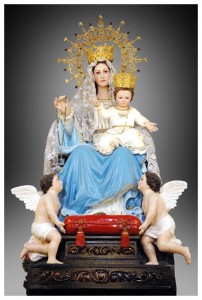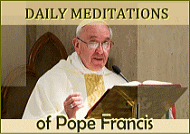Dubai, 17-19 January 2014
Homily of the Apostolic Nuncio
His Grace Archbishop Petar Rajič
Is 60: 1-6; Ps 71: 1-2,7-8, 10-13; Rom 12:9-16b; Lk 1:39-56
Praised, Tested and Crowned
Many of you will recall that on 14 January 2011, in the parish church of Ahmadi in Kuwait, Cardinal Antonio Cañizares Llovera, Prefect of the Congregation for Divine Worship and the Discipline of the Sacraments, officially proclaimed the Blessed Virgin Mary as Our Lady of Arabia and Patroness of the Arabian Peninsula. This was indeed a historical moment for the Church in this region of the world and one of great joy for all the faithful. Even though Mary the Mother of God has been venerated here for decades and her statute adorns every one of our churches in the Peninsula, she was not officially proclaimed Patroness of the Gulf until that year when a proper Mass for her solemnity was also approved.
The B.V.M. in Arabia. With this declaration, Mary has entered into the region of the Arabian Peninsula we now call our temporary home. History shows that in the first centuries of Christianity various missionaries arrived in the area known as Arabia in order to spread the Good news of the Gospel to the peoples that inhabited this part of the world. One of these missionaries and the best known, was St. Paul the Apostle, who in his Letter to the Galatians, described how after his conversion he went into Arabia, for a period of three years before commencing his apostolic ministry (Cf. Gal 1:15-17). During those first centuries, churches and even dioceses were established throughout the Peninsula. Recent archaeological discoveries have unearthed the foundations of Christian churches and monasteries, which only prove that Christians have been present in the region practically from the times of Christ the Lord. Though we do not know for certain if Mary ever travelled through Arabia, we now know that with her proclamation as Our Lady of Arabia, she is now spiritually present here in our places of worship, in our family homes, but most of all in the hearts of all the faithful who make recourse to her in their prayers. We are comforted by this fact, that the B.V.M. is that much closer to us now, as our spiritual Mother and model of faith and charity. Now that the B.V.M. is our Patroness, let us pray to her daily for all the needs of the Church in the Arabian Peninsula, especially for peace and unity. Let us also pray to her so that we Catholics, along with all the various Christian communities present in the region, may be granted more places of worship, where we will be able to gather in order to give praise and glory to Christ the Lord and his Mother Mary.
Mary was chosen for a special vocation, to become the Mother of God. The arrival of the Messiah was possible thanks to the faith of this simple woman of Nazareth. Today as in all feasts and holy days dedicated to the B.V.M., we are celebrating her great faith which was praised by her cousin Elisabeth, tested by God, and crowned by the Holy Trinity in heaven.
Mary praised by Elisabeth. Elisabeth praised Mary’s faith upon receiving her into her home: “Blessed are you among women, and blessed is the fruit of your womb. And why is this granted me, that the mother of my Lord should come to me? For behold, when the voice of your greeting came to my ears, the babe in my womb leaped for joy. And blessed is she who believed that there would be a fulfillment of what was spoken to her from the Lord” (Lk 1: 42-45).
Mary is considered blessed because she believed in the message given to her by God. We give glory to God for Mary’s great example of simple and humble acceptance of God’s word. Along with Elisabeth, we bless and praise Mary because she believed that there would be a fulfillment of what was spoken to her from the Lord. All who believe in the message of God are considered blessed as well. In the incredulous world we live in, it is truly a blessing to receive the gift of faith and yet this gift is constantly being offered to us by God. His message is ever present. How is it that the mother of my Lord comes to me as well? She has had an effect on the lives of so many people throughout the world and receives the prayers, devotion and veneration of millions who love her, at the shrines, churches, chapels dedicated to her and in the hearts of those who accept her into their homes.
Mary tested by God. While Mary was praised for her great faith, this faith was also put to the test throughout her life. She knew the life of poverty, of not having a decent place to give birth to her Son, of having to flee to Egypt in order to save the Child from the evil king Herod, of temporarily losing Jesus in Jerusalem when he was twelve years old, and finally of being by her Son’s side at Calvary when he was crucified on a cross. At that moment: “When Jesus saw his mother and the disciple whom he loved standing beside her, he said to his mother, ‘Woman, here is your son.’ Then he said to the disciple, ‘Here is your mother.’ And from that hour the disciple took her into his own home” (Jn 19:26-27). Despite all these hardships in her life, nowhere is it written that Mary ever despaired, complained or uttered a word against God. She simply shared in the suffering. Even though Mary was chosen for a special vocation, this did not mean that everything would be easy, even for her who was immaculately conceived and without stain of original sin! As Jesus could not avoid the cross, neither was Mary spared the suffering of the cross. She was put to the test through the sufferings of her Son and she passed her exam with the highest marks!
We too will never be spared the cross in our lives. Jesus has not called us to a life of comfort or laziness, but rather, he invites and challenges us to become great people! The test of our greatness before God is our humble acceptance of the crosses we must bear, with faith and courage, just like Mary. Jesus told John “here is your mother”. He handed his mother over to his beloved disciple during the moment of his greatest suffering. She was accepted into John’s home during her darkest moment, so that she would be consoled by Jesus’ disciple and not left alone and that both could console each other. We too can invite the Mother of God into our homes, into our lives, so that she becomes a part of our family and we become a part of her. Mary who knew many hardships in her life is also very close to us in our moments of suffering and shares them with us, by interceding before her Son so that we receive the graces we need to bear our pain with faith, trust and confidence in God.
Mary crowned Queen of Heaven. Finally, upon her assumption into heaven, the Church teaches us that Mary was crowned Queen of heaven by the Holy Trinity. This image is depicted in so many works of art throughout the world. Mary is not only the Mother of God, she is our Mother and Queen. Our relationship to Mary is that of a child to its mother. John the Apostle received Mary as his Mother from Jesus and Mary thereby became the mother of John. By this same action, we too have become Mary’s children since we are all disciples of the Lord and have been entrusted to her by Christ the Lord. Hence, we can rejoice and be comforted by the fact that we have Mary as our heavenly Mother and we can approach her in prayer throughout all the circumstances of our lives, with no inhibitions, just simple loving trust. Mary is at the same time our Queen. She now enjoys the reward of heaven and has received the crown of eternal life. We owe Mary therefore, the respect and obedience we would give to any queen on earth. Though she is our sovereign, Mary is a Queen who wants us to share in her crown. She does not want to keep the crown for herself, but seeks that all of God’s children may come to share in the glory of heaven.
May God grant each of us, through the intercession of the B.V.M., Our Lady of Arabia, the graces of unwavering faith and trust in God, perseverance during times of trial, and faithfulness to the end, so that we too may receive the crown of life!

